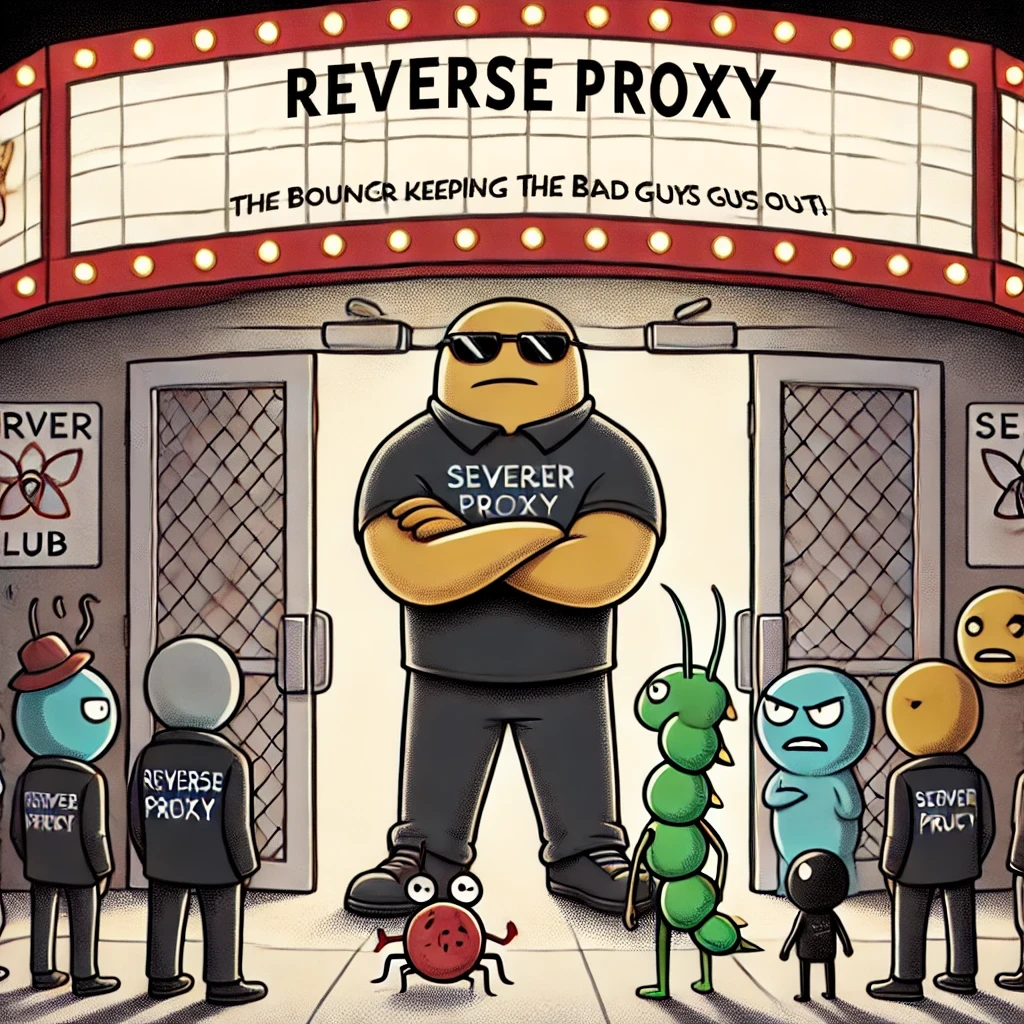WTF is Forward and Reverse Proxy
 Abou Zuhayr
Abou Zuhayr
Forward and reverse proxies—sounds like some kind of secret agents from a spy movie, right? Well, in the tech world, they might as well be! These sneaky little tools are the unsung heroes that keep our internet running smoothly, quietly managing traffic, boosting performance, and even thwarting hackers like they’re in the latest blockbuster. But what do they actually do? How do they work their magic? And why should you care?
Let’s embark on a journey to uncover the mystery of forward and reverse proxies by answering three burning questions:
What on Earth is a proxy?
How do these internet ninjas work?
Why do we need them (besides making us sound super tech-savvy)?
What is a Proxy?
Picture this: You want to talk to your crush, but you’re too shy. So, you send your charming friend to deliver the message instead. That friend? They’re your proxy. In the digital world, a proxy is like that middleman who handles all the awkward conversations between you (the client) and the server (your crush) without breaking a sweat.
Technically speaking, a proxy is a server that sits between your computer and the internet, managing your requests, fetching information, and even doing some neat tricks like caching or load balancing. Think of it as a really helpful personal assistant—minus the coffee runs.
How Do Proxies Work? (Hint: It’s Like a Digital Dance)
To understand proxies better, we need to separate the dynamic duo: forward proxies and reverse proxies. They might sound like names of superheroes (or possibly members of a boy band), but they play very different roles.

1. Forward Proxy: The Bodyguard of the Internet
A forward proxy is like a bodyguard who always stands between you and the big, bad internet. Imagine you want to access a website, but you don’t want the website to know who you are (maybe you’re doing some "research" on your ex’s new partner—no judgment!). Here’s where the forward proxy steps in:
Client Request: You send a request to your forward proxy. It’s like saying, “Hey, proxy buddy, can you check out what’s happening on that website for me?”
Proxy Server Actions: The forward proxy nods, puts on its best disguise, and heads over to the internet. If it finds what you’re looking for, it might even save the content (like a digital scrapbook) in case you ask for it again later. If not, it fetches the latest info directly from the website.
Server Response: The proxy brings back the goodies and hands them over to you, keeping your identity a secret like a true friend.
Forward proxies are used for:
Access Control: Blocking your employees from browsing cat memes all day.
Content Filtering: Keeping the bad stuff out (like a bouncer at a nightclub).
Caching: Speeding up your web browsing by saving copies of frequently visited pages.
Anonymity: Hiding your true identity, James Bond-style.
2. Reverse Proxy: The Unsung Butler of the Server World

Now, meet the reverse proxy—a server’s very own butler. Unlike the forward proxy, which protects the client (that’s you), the reverse proxy sits in front of a server (or servers), managing all incoming requests like an overly enthusiastic receptionist.
Client Request: When you try to visit a website, you actually end up talking to the reverse proxy first. It’s like showing up at a fancy restaurant and being greeted by the maître d’.
Proxy Server Actions: The reverse proxy decides which server in the kitchen should handle your request. Maybe it’s based on how busy the chefs are, or maybe the proxy just likes one server better (don’t we all have favorites?). The proxy also handles tasks like SSL decryption, so the servers can focus on what they do best—serving up content.
Server Response: The chosen server does its thing, hands the response back to the reverse proxy, which then passes it on to you, making sure everything is perfect (like a well-plated dish).
Reverse proxies are used for:
Load Balancing: Making sure no single server gets overwhelmed, like a mom with too many kids.
SSL Termination: Handling the tough security stuff so servers can chill.
Caching: Serving up cached content faster than a drive-thru.
Security: Protecting backend servers from cyber villains like a digital bouncer.
Why Do We Need Proxies? (The Fun Part!)
So, why are these proxies so important? Here’s why:
Security and Anonymity: Forward proxies hide your IP address, so you can browse the web without the fear of Big Brother (or your boss) watching. Reverse proxies, on the other hand, protect your servers from the dark forces of the internet, like DDoS attacks and cyber criminals. They’re like Gandalf shouting, “You shall not pass!”
Performance and Load Balancing: Proxies are like the internet’s personal trainers—they keep everything running smoothly and efficiently. Forward proxies can cache content, making web pages load faster than a toddler can spill juice. Reverse proxies distribute the traffic evenly across servers, ensuring no single server gets too much attention (because we all know how overwhelming that can be).
Access Control and Content Filtering: Proxies act like strict parents—they can block access to certain websites (goodbye, social media addiction) or filter out inappropriate content (sorry, no cat memes today).
Centralized Management: Proxies allow for centralized control and monitoring, making it easier to manage internet traffic, enforce policies, and keep everything under control—kind of like the internet’s very own hall monitor.
Conclusion
In the end, forward and reverse proxies are like the unsung heroes of the internet—always working behind the scenes to keep things running smoothly, securely, and efficiently. Whether they’re acting as digital bodyguards, butlers, or even internet ninjas, proxies play a crucial role in modern network architecture. So, the next time you’re surfing the web, remember to give a little nod to these digital warriors quietly working their magic.
And there you have it—the not-so-secret life of proxies!
Subscribe to my newsletter
Read articles from Abou Zuhayr directly inside your inbox. Subscribe to the newsletter, and don't miss out.
Written by

Abou Zuhayr
Abou Zuhayr
Hey, I’m Abou Zuhayr, Android developer by day, wannabe rockstar by night. With 6 years of Android wizardry under my belt and currently working at Gather.ai, I've successfully convinced multiple devices to do my bidding while pretending I'm not secretly just turning them off and on again. I’m also deeply embedded (pun intended) in systems that make you question if they’re alive. When I'm not fixing bugs that aren’t my fault (I swear!), I’m serenading my code with guitar riffs or drumming away the frustration of yet another NullPointerException. Oh, and I write sometimes – mostly about how Android development feels like extreme sport mixed with jazz improvisation. Looking for new challenges in tech that don’t involve my devices plotting against me!